BHP Billiton and ANZ Bank Analysis
VerifiedAdded on 2019/10/30
|15
|3159
|67
Report
AI Summary
This report provides a comprehensive financial analysis of BHP Billiton and ANZ Bank, comparing their financial ratios, capital structures, and corporate governance practices. The report examines the companies' frameworks, major sources of finance, and sustainability efforts. It highlights similarities in corporate governance and sustainability commitments, while also noting differences in capital management and credit ratings. The analysis reveals that BHP relies more on debt financing, while ANZ has a more stagnant capital structure. Both companies have experienced a decline in profitability, which needs to be addressed. The report concludes with findings and recommendations for both companies, emphasizing the impact of market fluctuations on their performance.
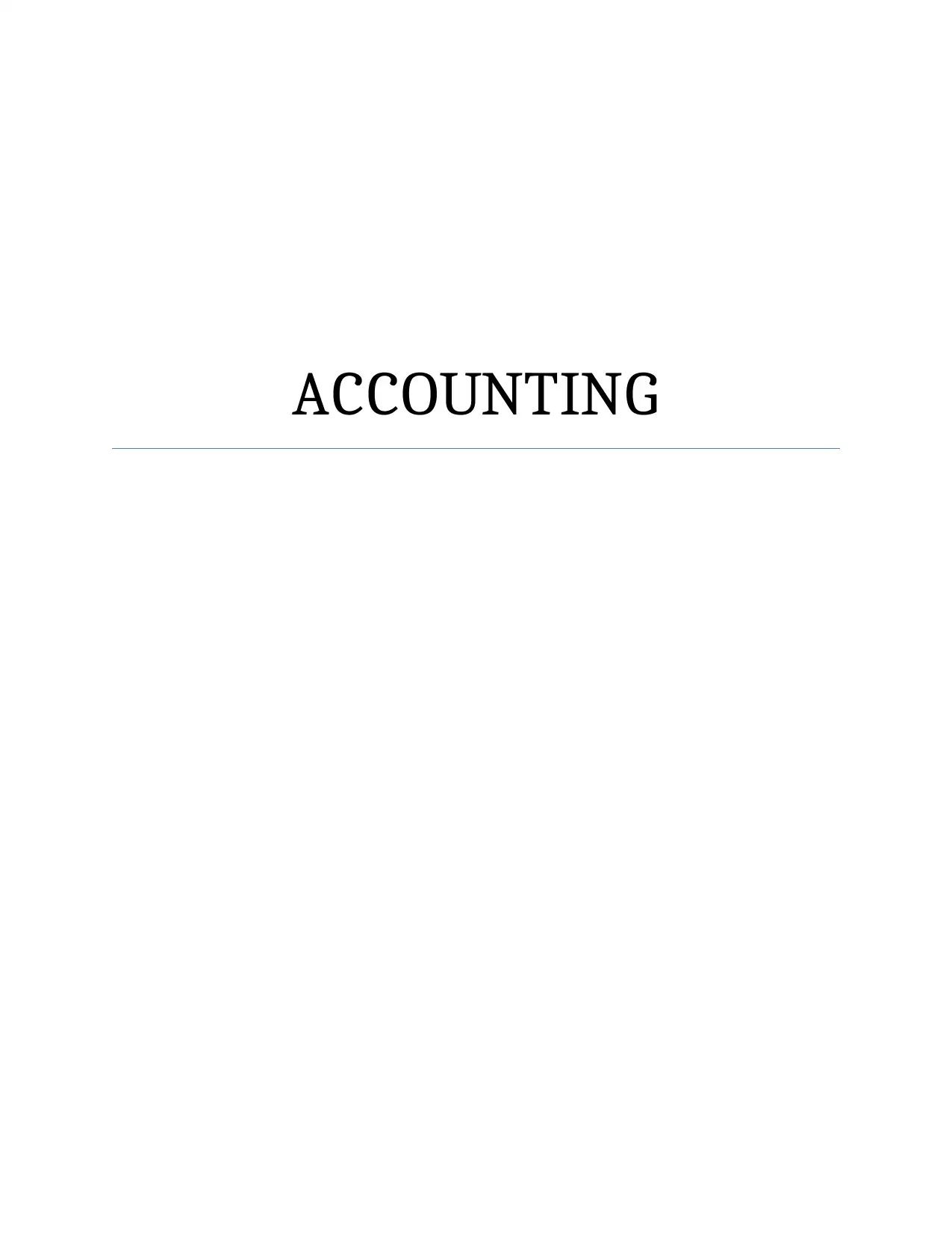
ACCOUNTING
Paraphrase This Document
Need a fresh take? Get an instant paraphrase of this document with our AI Paraphraser
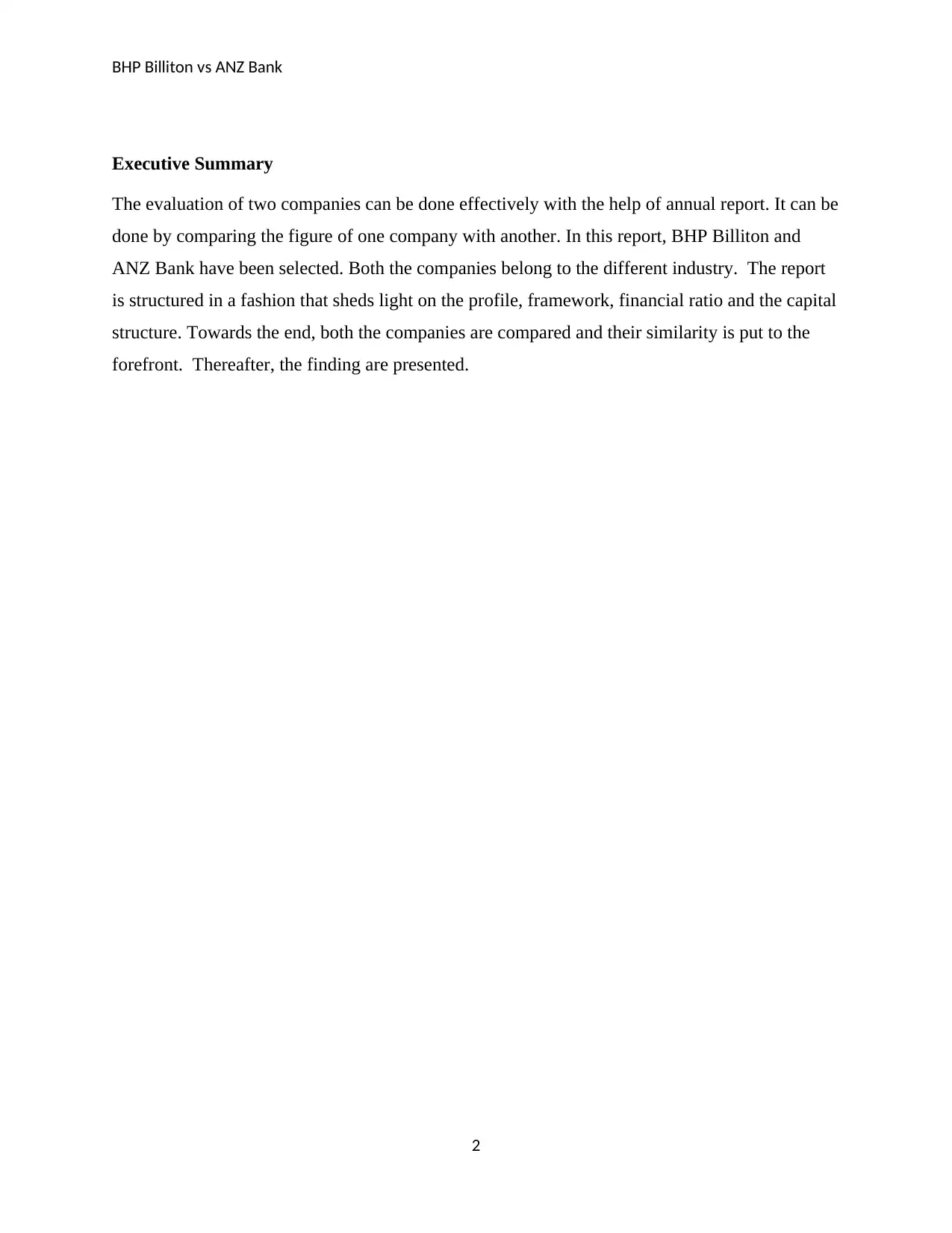
BHP Billiton vs ANZ Bank
Executive Summary
The evaluation of two companies can be done effectively with the help of annual report. It can be
done by comparing the figure of one company with another. In this report, BHP Billiton and
ANZ Bank have been selected. Both the companies belong to the different industry. The report
is structured in a fashion that sheds light on the profile, framework, financial ratio and the capital
structure. Towards the end, both the companies are compared and their similarity is put to the
forefront. Thereafter, the finding are presented.
2
Executive Summary
The evaluation of two companies can be done effectively with the help of annual report. It can be
done by comparing the figure of one company with another. In this report, BHP Billiton and
ANZ Bank have been selected. Both the companies belong to the different industry. The report
is structured in a fashion that sheds light on the profile, framework, financial ratio and the capital
structure. Towards the end, both the companies are compared and their similarity is put to the
forefront. Thereafter, the finding are presented.
2
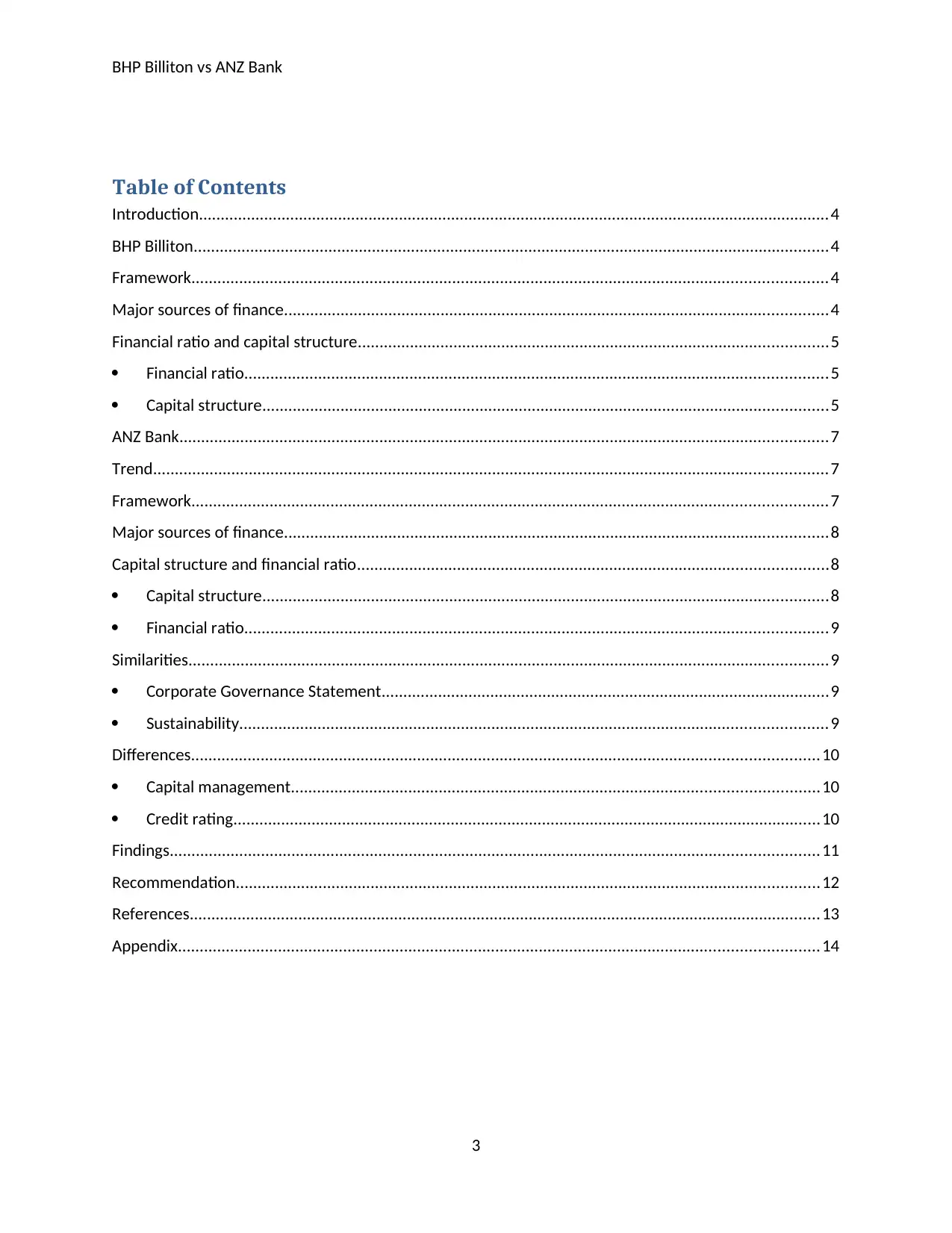
BHP Billiton vs ANZ Bank
Table of Contents
Introduction.................................................................................................................................................4
BHP Billiton..................................................................................................................................................4
Framework..................................................................................................................................................4
Major sources of finance.............................................................................................................................4
Financial ratio and capital structure............................................................................................................5
Financial ratio......................................................................................................................................5
Capital structure..................................................................................................................................5
ANZ Bank.....................................................................................................................................................7
Trend...........................................................................................................................................................7
Framework..................................................................................................................................................7
Major sources of finance.............................................................................................................................8
Capital structure and financial ratio............................................................................................................8
Capital structure..................................................................................................................................8
Financial ratio......................................................................................................................................9
Similarities...................................................................................................................................................9
Corporate Governance Statement.......................................................................................................9
Sustainability.......................................................................................................................................9
Differences................................................................................................................................................10
Capital management.........................................................................................................................10
Credit rating.......................................................................................................................................10
Findings.....................................................................................................................................................11
Recommendation......................................................................................................................................12
References.................................................................................................................................................13
Appendix...................................................................................................................................................14
3
Table of Contents
Introduction.................................................................................................................................................4
BHP Billiton..................................................................................................................................................4
Framework..................................................................................................................................................4
Major sources of finance.............................................................................................................................4
Financial ratio and capital structure............................................................................................................5
Financial ratio......................................................................................................................................5
Capital structure..................................................................................................................................5
ANZ Bank.....................................................................................................................................................7
Trend...........................................................................................................................................................7
Framework..................................................................................................................................................7
Major sources of finance.............................................................................................................................8
Capital structure and financial ratio............................................................................................................8
Capital structure..................................................................................................................................8
Financial ratio......................................................................................................................................9
Similarities...................................................................................................................................................9
Corporate Governance Statement.......................................................................................................9
Sustainability.......................................................................................................................................9
Differences................................................................................................................................................10
Capital management.........................................................................................................................10
Credit rating.......................................................................................................................................10
Findings.....................................................................................................................................................11
Recommendation......................................................................................................................................12
References.................................................................................................................................................13
Appendix...................................................................................................................................................14
3
⊘ This is a preview!⊘
Do you want full access?
Subscribe today to unlock all pages.

Trusted by 1+ million students worldwide
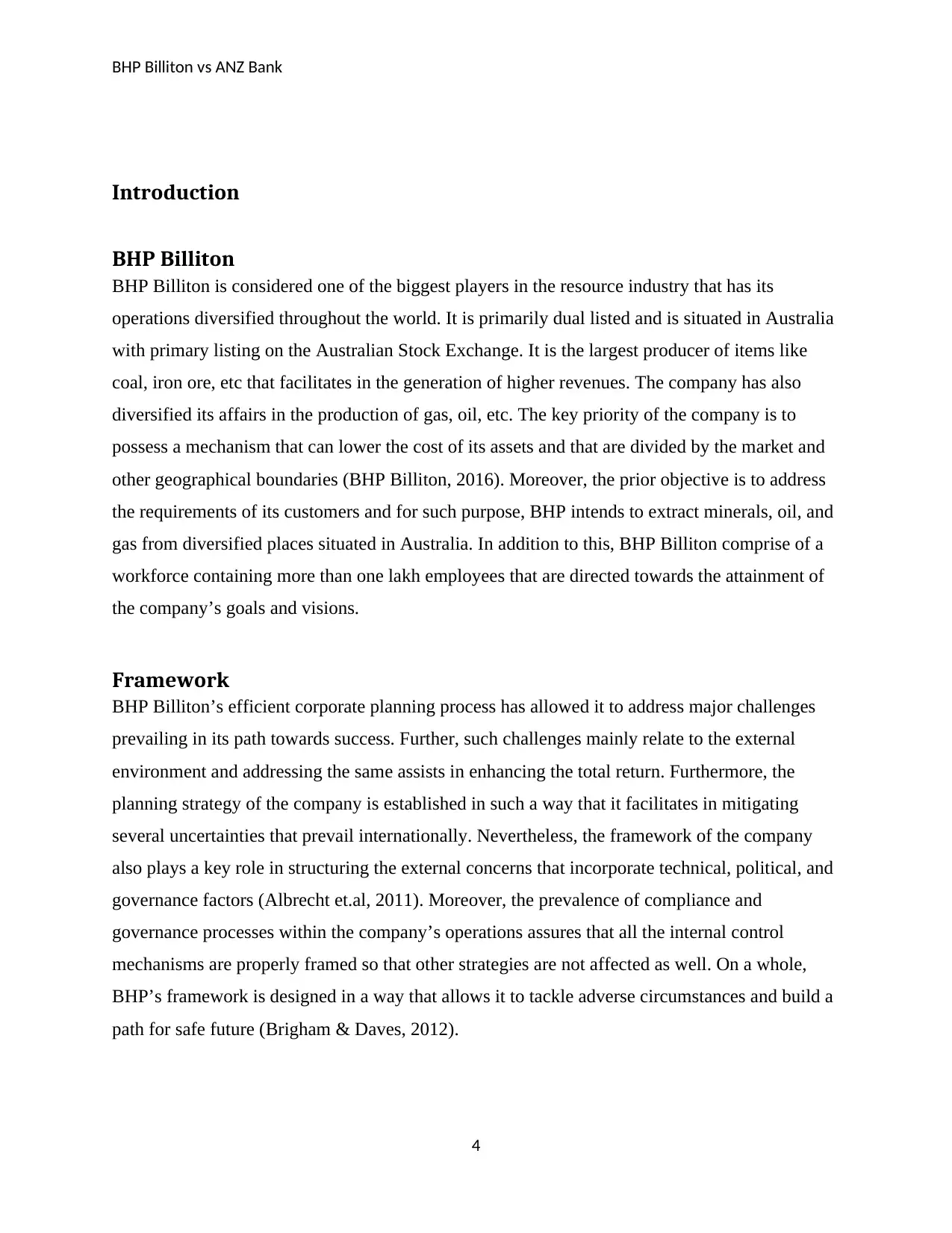
BHP Billiton vs ANZ Bank
Introduction
BHP Billiton
BHP Billiton is considered one of the biggest players in the resource industry that has its
operations diversified throughout the world. It is primarily dual listed and is situated in Australia
with primary listing on the Australian Stock Exchange. It is the largest producer of items like
coal, iron ore, etc that facilitates in the generation of higher revenues. The company has also
diversified its affairs in the production of gas, oil, etc. The key priority of the company is to
possess a mechanism that can lower the cost of its assets and that are divided by the market and
other geographical boundaries (BHP Billiton, 2016). Moreover, the prior objective is to address
the requirements of its customers and for such purpose, BHP intends to extract minerals, oil, and
gas from diversified places situated in Australia. In addition to this, BHP Billiton comprise of a
workforce containing more than one lakh employees that are directed towards the attainment of
the company’s goals and visions.
Framework
BHP Billiton’s efficient corporate planning process has allowed it to address major challenges
prevailing in its path towards success. Further, such challenges mainly relate to the external
environment and addressing the same assists in enhancing the total return. Furthermore, the
planning strategy of the company is established in such a way that it facilitates in mitigating
several uncertainties that prevail internationally. Nevertheless, the framework of the company
also plays a key role in structuring the external concerns that incorporate technical, political, and
governance factors (Albrecht et.al, 2011). Moreover, the prevalence of compliance and
governance processes within the company’s operations assures that all the internal control
mechanisms are properly framed so that other strategies are not affected as well. On a whole,
BHP’s framework is designed in a way that allows it to tackle adverse circumstances and build a
path for safe future (Brigham & Daves, 2012).
4
Introduction
BHP Billiton
BHP Billiton is considered one of the biggest players in the resource industry that has its
operations diversified throughout the world. It is primarily dual listed and is situated in Australia
with primary listing on the Australian Stock Exchange. It is the largest producer of items like
coal, iron ore, etc that facilitates in the generation of higher revenues. The company has also
diversified its affairs in the production of gas, oil, etc. The key priority of the company is to
possess a mechanism that can lower the cost of its assets and that are divided by the market and
other geographical boundaries (BHP Billiton, 2016). Moreover, the prior objective is to address
the requirements of its customers and for such purpose, BHP intends to extract minerals, oil, and
gas from diversified places situated in Australia. In addition to this, BHP Billiton comprise of a
workforce containing more than one lakh employees that are directed towards the attainment of
the company’s goals and visions.
Framework
BHP Billiton’s efficient corporate planning process has allowed it to address major challenges
prevailing in its path towards success. Further, such challenges mainly relate to the external
environment and addressing the same assists in enhancing the total return. Furthermore, the
planning strategy of the company is established in such a way that it facilitates in mitigating
several uncertainties that prevail internationally. Nevertheless, the framework of the company
also plays a key role in structuring the external concerns that incorporate technical, political, and
governance factors (Albrecht et.al, 2011). Moreover, the prevalence of compliance and
governance processes within the company’s operations assures that all the internal control
mechanisms are properly framed so that other strategies are not affected as well. On a whole,
BHP’s framework is designed in a way that allows it to tackle adverse circumstances and build a
path for safe future (Brigham & Daves, 2012).
4
Paraphrase This Document
Need a fresh take? Get an instant paraphrase of this document with our AI Paraphraser
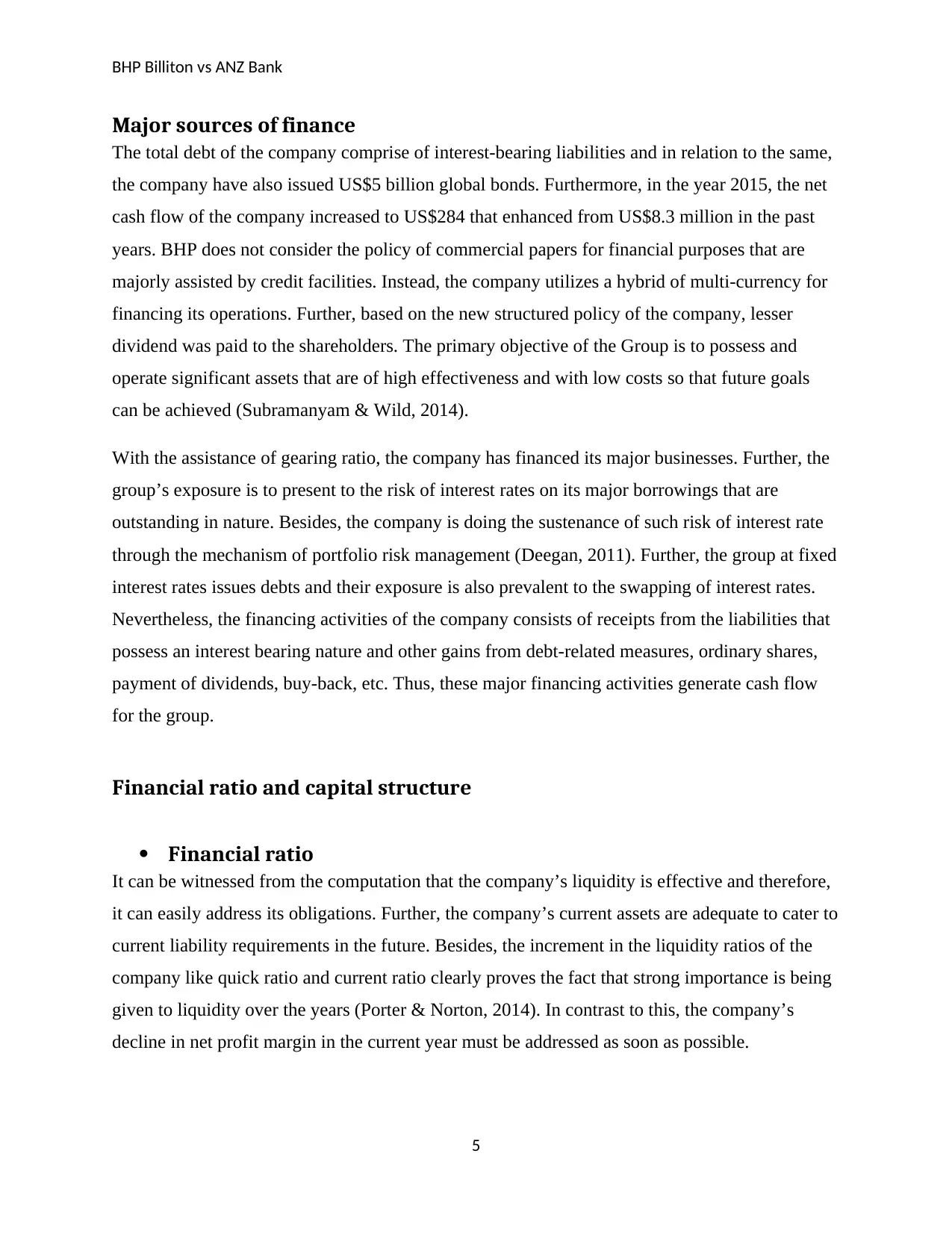
BHP Billiton vs ANZ Bank
Major sources of finance
The total debt of the company comprise of interest-bearing liabilities and in relation to the same,
the company have also issued US$5 billion global bonds. Furthermore, in the year 2015, the net
cash flow of the company increased to US$284 that enhanced from US$8.3 million in the past
years. BHP does not consider the policy of commercial papers for financial purposes that are
majorly assisted by credit facilities. Instead, the company utilizes a hybrid of multi-currency for
financing its operations. Further, based on the new structured policy of the company, lesser
dividend was paid to the shareholders. The primary objective of the Group is to possess and
operate significant assets that are of high effectiveness and with low costs so that future goals
can be achieved (Subramanyam & Wild, 2014).
With the assistance of gearing ratio, the company has financed its major businesses. Further, the
group’s exposure is to present to the risk of interest rates on its major borrowings that are
outstanding in nature. Besides, the company is doing the sustenance of such risk of interest rate
through the mechanism of portfolio risk management (Deegan, 2011). Further, the group at fixed
interest rates issues debts and their exposure is also prevalent to the swapping of interest rates.
Nevertheless, the financing activities of the company consists of receipts from the liabilities that
possess an interest bearing nature and other gains from debt-related measures, ordinary shares,
payment of dividends, buy-back, etc. Thus, these major financing activities generate cash flow
for the group.
Financial ratio and capital structure
Financial ratio
It can be witnessed from the computation that the company’s liquidity is effective and therefore,
it can easily address its obligations. Further, the company’s current assets are adequate to cater to
current liability requirements in the future. Besides, the increment in the liquidity ratios of the
company like quick ratio and current ratio clearly proves the fact that strong importance is being
given to liquidity over the years (Porter & Norton, 2014). In contrast to this, the company’s
decline in net profit margin in the current year must be addressed as soon as possible.
5
Major sources of finance
The total debt of the company comprise of interest-bearing liabilities and in relation to the same,
the company have also issued US$5 billion global bonds. Furthermore, in the year 2015, the net
cash flow of the company increased to US$284 that enhanced from US$8.3 million in the past
years. BHP does not consider the policy of commercial papers for financial purposes that are
majorly assisted by credit facilities. Instead, the company utilizes a hybrid of multi-currency for
financing its operations. Further, based on the new structured policy of the company, lesser
dividend was paid to the shareholders. The primary objective of the Group is to possess and
operate significant assets that are of high effectiveness and with low costs so that future goals
can be achieved (Subramanyam & Wild, 2014).
With the assistance of gearing ratio, the company has financed its major businesses. Further, the
group’s exposure is to present to the risk of interest rates on its major borrowings that are
outstanding in nature. Besides, the company is doing the sustenance of such risk of interest rate
through the mechanism of portfolio risk management (Deegan, 2011). Further, the group at fixed
interest rates issues debts and their exposure is also prevalent to the swapping of interest rates.
Nevertheless, the financing activities of the company consists of receipts from the liabilities that
possess an interest bearing nature and other gains from debt-related measures, ordinary shares,
payment of dividends, buy-back, etc. Thus, these major financing activities generate cash flow
for the group.
Financial ratio and capital structure
Financial ratio
It can be witnessed from the computation that the company’s liquidity is effective and therefore,
it can easily address its obligations. Further, the company’s current assets are adequate to cater to
current liability requirements in the future. Besides, the increment in the liquidity ratios of the
company like quick ratio and current ratio clearly proves the fact that strong importance is being
given to liquidity over the years (Porter & Norton, 2014). In contrast to this, the company’s
decline in net profit margin in the current year must be addressed as soon as possible.
5
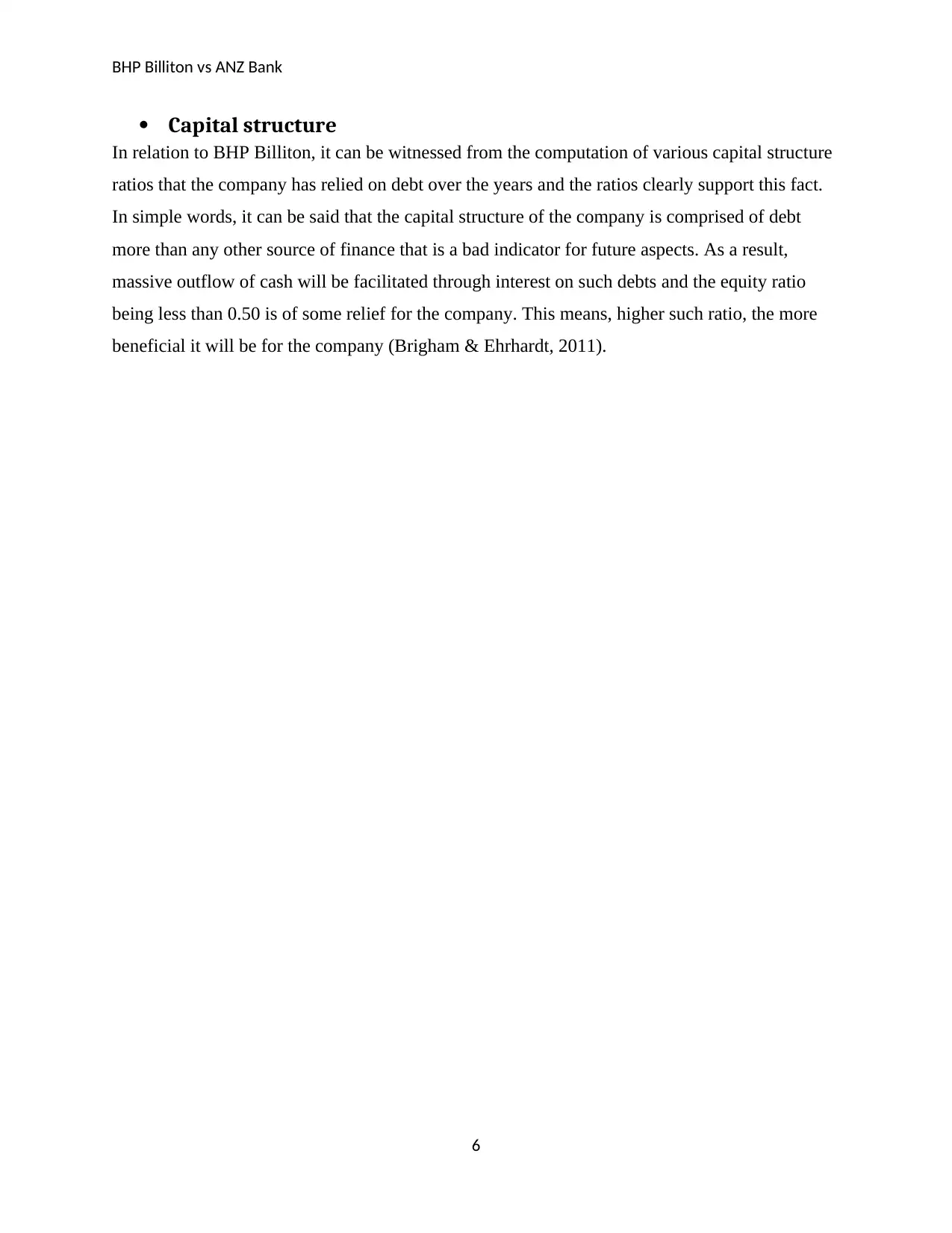
BHP Billiton vs ANZ Bank
Capital structure
In relation to BHP Billiton, it can be witnessed from the computation of various capital structure
ratios that the company has relied on debt over the years and the ratios clearly support this fact.
In simple words, it can be said that the capital structure of the company is comprised of debt
more than any other source of finance that is a bad indicator for future aspects. As a result,
massive outflow of cash will be facilitated through interest on such debts and the equity ratio
being less than 0.50 is of some relief for the company. This means, higher such ratio, the more
beneficial it will be for the company (Brigham & Ehrhardt, 2011).
6
Capital structure
In relation to BHP Billiton, it can be witnessed from the computation of various capital structure
ratios that the company has relied on debt over the years and the ratios clearly support this fact.
In simple words, it can be said that the capital structure of the company is comprised of debt
more than any other source of finance that is a bad indicator for future aspects. As a result,
massive outflow of cash will be facilitated through interest on such debts and the equity ratio
being less than 0.50 is of some relief for the company. This means, higher such ratio, the more
beneficial it will be for the company (Brigham & Ehrhardt, 2011).
6
⊘ This is a preview!⊘
Do you want full access?
Subscribe today to unlock all pages.

Trusted by 1+ million students worldwide
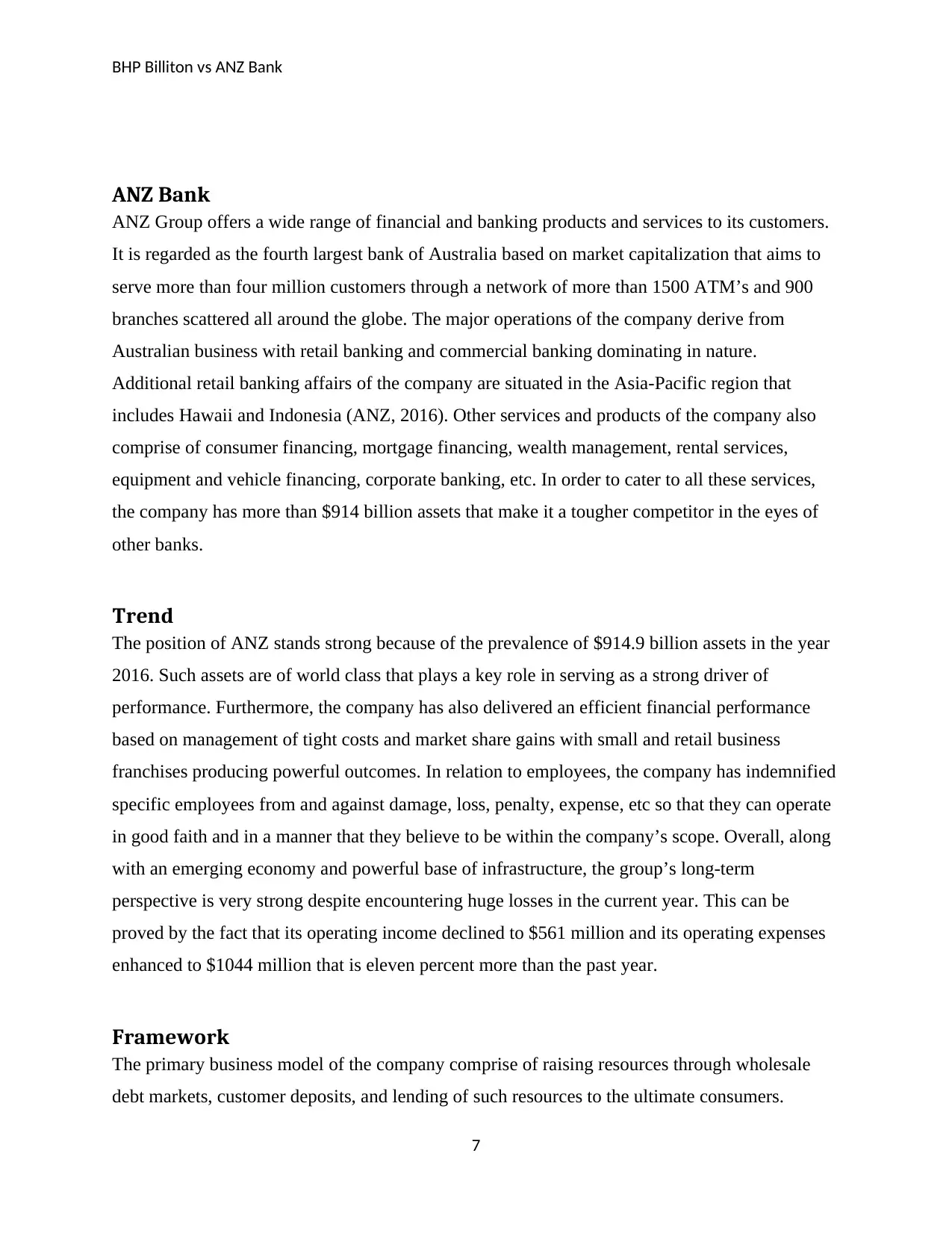
BHP Billiton vs ANZ Bank
ANZ Bank
ANZ Group offers a wide range of financial and banking products and services to its customers.
It is regarded as the fourth largest bank of Australia based on market capitalization that aims to
serve more than four million customers through a network of more than 1500 ATM’s and 900
branches scattered all around the globe. The major operations of the company derive from
Australian business with retail banking and commercial banking dominating in nature.
Additional retail banking affairs of the company are situated in the Asia-Pacific region that
includes Hawaii and Indonesia (ANZ, 2016). Other services and products of the company also
comprise of consumer financing, mortgage financing, wealth management, rental services,
equipment and vehicle financing, corporate banking, etc. In order to cater to all these services,
the company has more than $914 billion assets that make it a tougher competitor in the eyes of
other banks.
Trend
The position of ANZ stands strong because of the prevalence of $914.9 billion assets in the year
2016. Such assets are of world class that plays a key role in serving as a strong driver of
performance. Furthermore, the company has also delivered an efficient financial performance
based on management of tight costs and market share gains with small and retail business
franchises producing powerful outcomes. In relation to employees, the company has indemnified
specific employees from and against damage, loss, penalty, expense, etc so that they can operate
in good faith and in a manner that they believe to be within the company’s scope. Overall, along
with an emerging economy and powerful base of infrastructure, the group’s long-term
perspective is very strong despite encountering huge losses in the current year. This can be
proved by the fact that its operating income declined to $561 million and its operating expenses
enhanced to $1044 million that is eleven percent more than the past year.
Framework
The primary business model of the company comprise of raising resources through wholesale
debt markets, customer deposits, and lending of such resources to the ultimate consumers.
7
ANZ Bank
ANZ Group offers a wide range of financial and banking products and services to its customers.
It is regarded as the fourth largest bank of Australia based on market capitalization that aims to
serve more than four million customers through a network of more than 1500 ATM’s and 900
branches scattered all around the globe. The major operations of the company derive from
Australian business with retail banking and commercial banking dominating in nature.
Additional retail banking affairs of the company are situated in the Asia-Pacific region that
includes Hawaii and Indonesia (ANZ, 2016). Other services and products of the company also
comprise of consumer financing, mortgage financing, wealth management, rental services,
equipment and vehicle financing, corporate banking, etc. In order to cater to all these services,
the company has more than $914 billion assets that make it a tougher competitor in the eyes of
other banks.
Trend
The position of ANZ stands strong because of the prevalence of $914.9 billion assets in the year
2016. Such assets are of world class that plays a key role in serving as a strong driver of
performance. Furthermore, the company has also delivered an efficient financial performance
based on management of tight costs and market share gains with small and retail business
franchises producing powerful outcomes. In relation to employees, the company has indemnified
specific employees from and against damage, loss, penalty, expense, etc so that they can operate
in good faith and in a manner that they believe to be within the company’s scope. Overall, along
with an emerging economy and powerful base of infrastructure, the group’s long-term
perspective is very strong despite encountering huge losses in the current year. This can be
proved by the fact that its operating income declined to $561 million and its operating expenses
enhanced to $1044 million that is eleven percent more than the past year.
Framework
The primary business model of the company comprise of raising resources through wholesale
debt markets, customer deposits, and lending of such resources to the ultimate consumers.
7
Paraphrase This Document
Need a fresh take? Get an instant paraphrase of this document with our AI Paraphraser
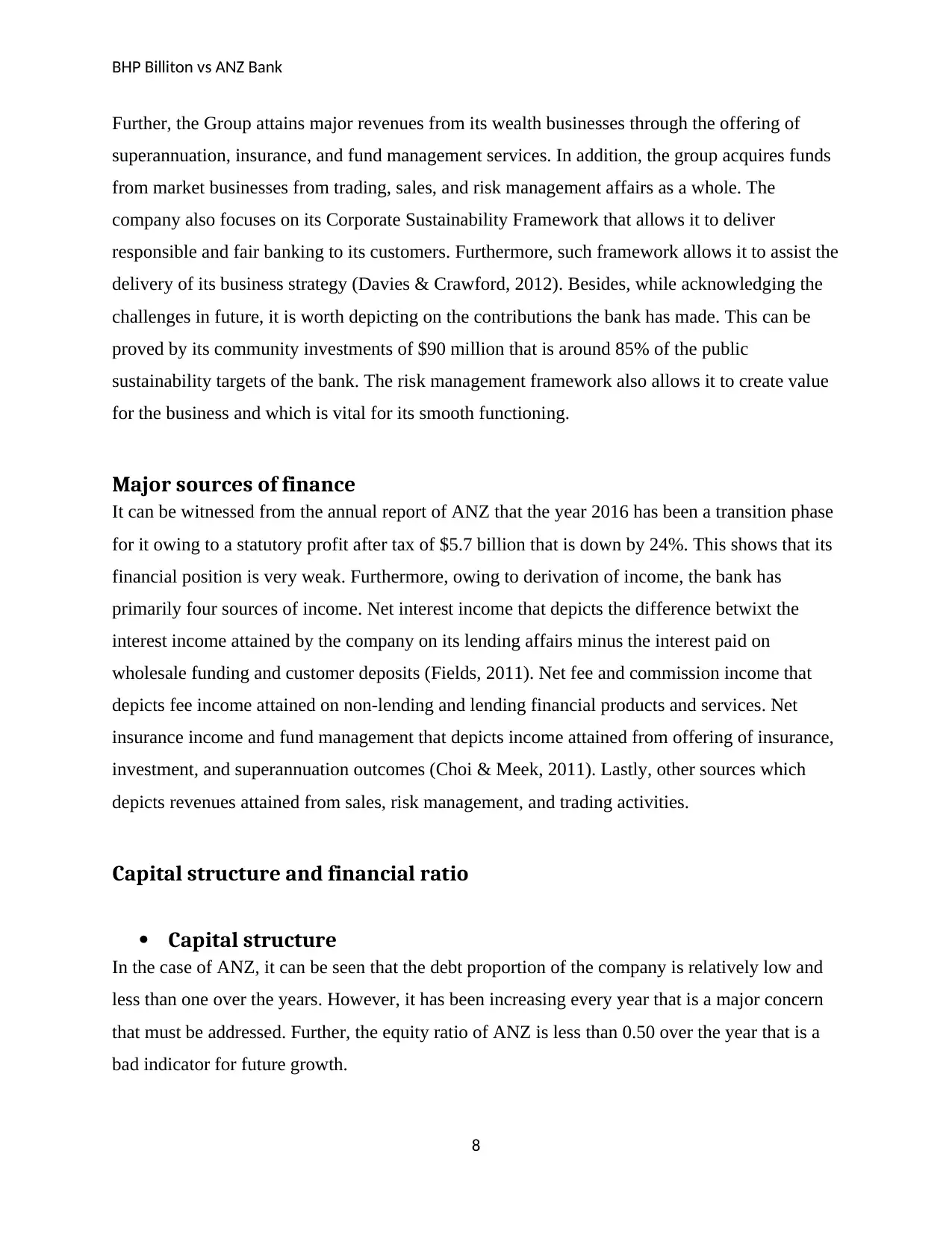
BHP Billiton vs ANZ Bank
Further, the Group attains major revenues from its wealth businesses through the offering of
superannuation, insurance, and fund management services. In addition, the group acquires funds
from market businesses from trading, sales, and risk management affairs as a whole. The
company also focuses on its Corporate Sustainability Framework that allows it to deliver
responsible and fair banking to its customers. Furthermore, such framework allows it to assist the
delivery of its business strategy (Davies & Crawford, 2012). Besides, while acknowledging the
challenges in future, it is worth depicting on the contributions the bank has made. This can be
proved by its community investments of $90 million that is around 85% of the public
sustainability targets of the bank. The risk management framework also allows it to create value
for the business and which is vital for its smooth functioning.
Major sources of finance
It can be witnessed from the annual report of ANZ that the year 2016 has been a transition phase
for it owing to a statutory profit after tax of $5.7 billion that is down by 24%. This shows that its
financial position is very weak. Furthermore, owing to derivation of income, the bank has
primarily four sources of income. Net interest income that depicts the difference betwixt the
interest income attained by the company on its lending affairs minus the interest paid on
wholesale funding and customer deposits (Fields, 2011). Net fee and commission income that
depicts fee income attained on non-lending and lending financial products and services. Net
insurance income and fund management that depicts income attained from offering of insurance,
investment, and superannuation outcomes (Choi & Meek, 2011). Lastly, other sources which
depicts revenues attained from sales, risk management, and trading activities.
Capital structure and financial ratio
Capital structure
In the case of ANZ, it can be seen that the debt proportion of the company is relatively low and
less than one over the years. However, it has been increasing every year that is a major concern
that must be addressed. Further, the equity ratio of ANZ is less than 0.50 over the year that is a
bad indicator for future growth.
8
Further, the Group attains major revenues from its wealth businesses through the offering of
superannuation, insurance, and fund management services. In addition, the group acquires funds
from market businesses from trading, sales, and risk management affairs as a whole. The
company also focuses on its Corporate Sustainability Framework that allows it to deliver
responsible and fair banking to its customers. Furthermore, such framework allows it to assist the
delivery of its business strategy (Davies & Crawford, 2012). Besides, while acknowledging the
challenges in future, it is worth depicting on the contributions the bank has made. This can be
proved by its community investments of $90 million that is around 85% of the public
sustainability targets of the bank. The risk management framework also allows it to create value
for the business and which is vital for its smooth functioning.
Major sources of finance
It can be witnessed from the annual report of ANZ that the year 2016 has been a transition phase
for it owing to a statutory profit after tax of $5.7 billion that is down by 24%. This shows that its
financial position is very weak. Furthermore, owing to derivation of income, the bank has
primarily four sources of income. Net interest income that depicts the difference betwixt the
interest income attained by the company on its lending affairs minus the interest paid on
wholesale funding and customer deposits (Fields, 2011). Net fee and commission income that
depicts fee income attained on non-lending and lending financial products and services. Net
insurance income and fund management that depicts income attained from offering of insurance,
investment, and superannuation outcomes (Choi & Meek, 2011). Lastly, other sources which
depicts revenues attained from sales, risk management, and trading activities.
Capital structure and financial ratio
Capital structure
In the case of ANZ, it can be seen that the debt proportion of the company is relatively low and
less than one over the years. However, it has been increasing every year that is a major concern
that must be addressed. Further, the equity ratio of ANZ is less than 0.50 over the year that is a
bad indicator for future growth.
8
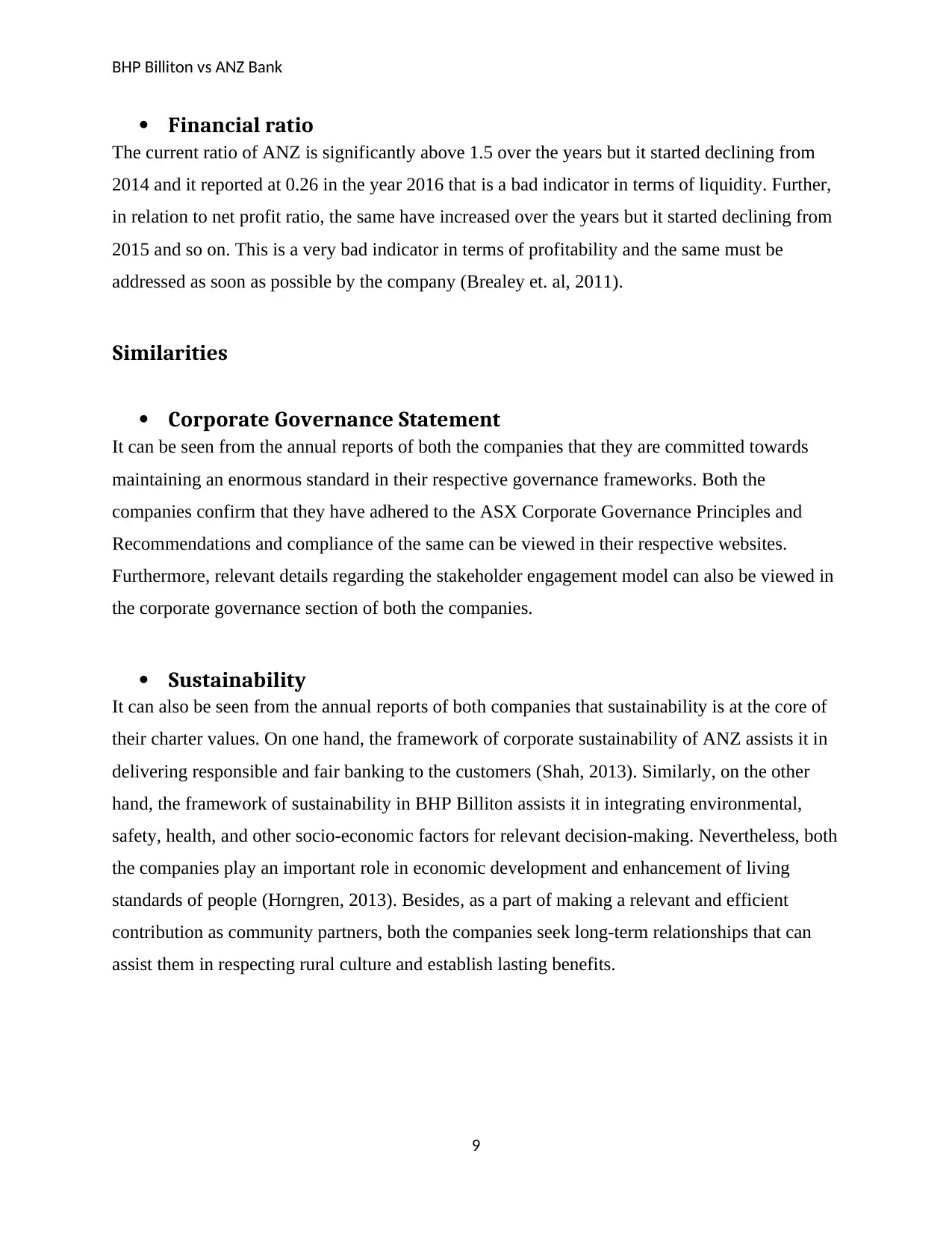
BHP Billiton vs ANZ Bank
Financial ratio
The current ratio of ANZ is significantly above 1.5 over the years but it started declining from
2014 and it reported at 0.26 in the year 2016 that is a bad indicator in terms of liquidity. Further,
in relation to net profit ratio, the same have increased over the years but it started declining from
2015 and so on. This is a very bad indicator in terms of profitability and the same must be
addressed as soon as possible by the company (Brealey et. al, 2011).
Similarities
Corporate Governance Statement
It can be seen from the annual reports of both the companies that they are committed towards
maintaining an enormous standard in their respective governance frameworks. Both the
companies confirm that they have adhered to the ASX Corporate Governance Principles and
Recommendations and compliance of the same can be viewed in their respective websites.
Furthermore, relevant details regarding the stakeholder engagement model can also be viewed in
the corporate governance section of both the companies.
Sustainability
It can also be seen from the annual reports of both companies that sustainability is at the core of
their charter values. On one hand, the framework of corporate sustainability of ANZ assists it in
delivering responsible and fair banking to the customers (Shah, 2013). Similarly, on the other
hand, the framework of sustainability in BHP Billiton assists it in integrating environmental,
safety, health, and other socio-economic factors for relevant decision-making. Nevertheless, both
the companies play an important role in economic development and enhancement of living
standards of people (Horngren, 2013). Besides, as a part of making a relevant and efficient
contribution as community partners, both the companies seek long-term relationships that can
assist them in respecting rural culture and establish lasting benefits.
9
Financial ratio
The current ratio of ANZ is significantly above 1.5 over the years but it started declining from
2014 and it reported at 0.26 in the year 2016 that is a bad indicator in terms of liquidity. Further,
in relation to net profit ratio, the same have increased over the years but it started declining from
2015 and so on. This is a very bad indicator in terms of profitability and the same must be
addressed as soon as possible by the company (Brealey et. al, 2011).
Similarities
Corporate Governance Statement
It can be seen from the annual reports of both the companies that they are committed towards
maintaining an enormous standard in their respective governance frameworks. Both the
companies confirm that they have adhered to the ASX Corporate Governance Principles and
Recommendations and compliance of the same can be viewed in their respective websites.
Furthermore, relevant details regarding the stakeholder engagement model can also be viewed in
the corporate governance section of both the companies.
Sustainability
It can also be seen from the annual reports of both companies that sustainability is at the core of
their charter values. On one hand, the framework of corporate sustainability of ANZ assists it in
delivering responsible and fair banking to the customers (Shah, 2013). Similarly, on the other
hand, the framework of sustainability in BHP Billiton assists it in integrating environmental,
safety, health, and other socio-economic factors for relevant decision-making. Nevertheless, both
the companies play an important role in economic development and enhancement of living
standards of people (Horngren, 2013). Besides, as a part of making a relevant and efficient
contribution as community partners, both the companies seek long-term relationships that can
assist them in respecting rural culture and establish lasting benefits.
9
⊘ This is a preview!⊘
Do you want full access?
Subscribe today to unlock all pages.

Trusted by 1+ million students worldwide
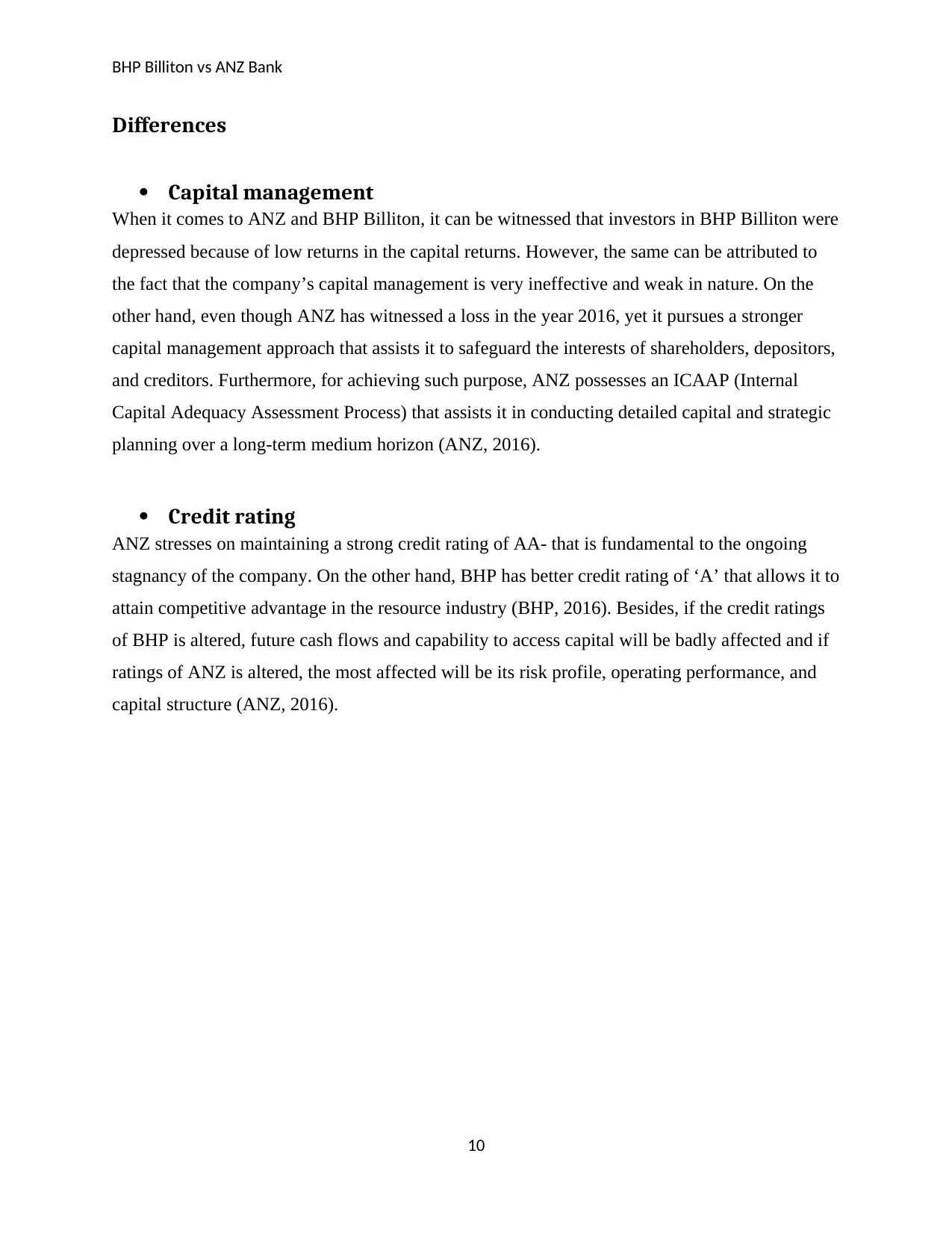
BHP Billiton vs ANZ Bank
Differences
Capital management
When it comes to ANZ and BHP Billiton, it can be witnessed that investors in BHP Billiton were
depressed because of low returns in the capital returns. However, the same can be attributed to
the fact that the company’s capital management is very ineffective and weak in nature. On the
other hand, even though ANZ has witnessed a loss in the year 2016, yet it pursues a stronger
capital management approach that assists it to safeguard the interests of shareholders, depositors,
and creditors. Furthermore, for achieving such purpose, ANZ possesses an ICAAP (Internal
Capital Adequacy Assessment Process) that assists it in conducting detailed capital and strategic
planning over a long-term medium horizon (ANZ, 2016).
Credit rating
ANZ stresses on maintaining a strong credit rating of AA- that is fundamental to the ongoing
stagnancy of the company. On the other hand, BHP has better credit rating of ‘A’ that allows it to
attain competitive advantage in the resource industry (BHP, 2016). Besides, if the credit ratings
of BHP is altered, future cash flows and capability to access capital will be badly affected and if
ratings of ANZ is altered, the most affected will be its risk profile, operating performance, and
capital structure (ANZ, 2016).
10
Differences
Capital management
When it comes to ANZ and BHP Billiton, it can be witnessed that investors in BHP Billiton were
depressed because of low returns in the capital returns. However, the same can be attributed to
the fact that the company’s capital management is very ineffective and weak in nature. On the
other hand, even though ANZ has witnessed a loss in the year 2016, yet it pursues a stronger
capital management approach that assists it to safeguard the interests of shareholders, depositors,
and creditors. Furthermore, for achieving such purpose, ANZ possesses an ICAAP (Internal
Capital Adequacy Assessment Process) that assists it in conducting detailed capital and strategic
planning over a long-term medium horizon (ANZ, 2016).
Credit rating
ANZ stresses on maintaining a strong credit rating of AA- that is fundamental to the ongoing
stagnancy of the company. On the other hand, BHP has better credit rating of ‘A’ that allows it to
attain competitive advantage in the resource industry (BHP, 2016). Besides, if the credit ratings
of BHP is altered, future cash flows and capability to access capital will be badly affected and if
ratings of ANZ is altered, the most affected will be its risk profile, operating performance, and
capital structure (ANZ, 2016).
10
Paraphrase This Document
Need a fresh take? Get an instant paraphrase of this document with our AI Paraphraser
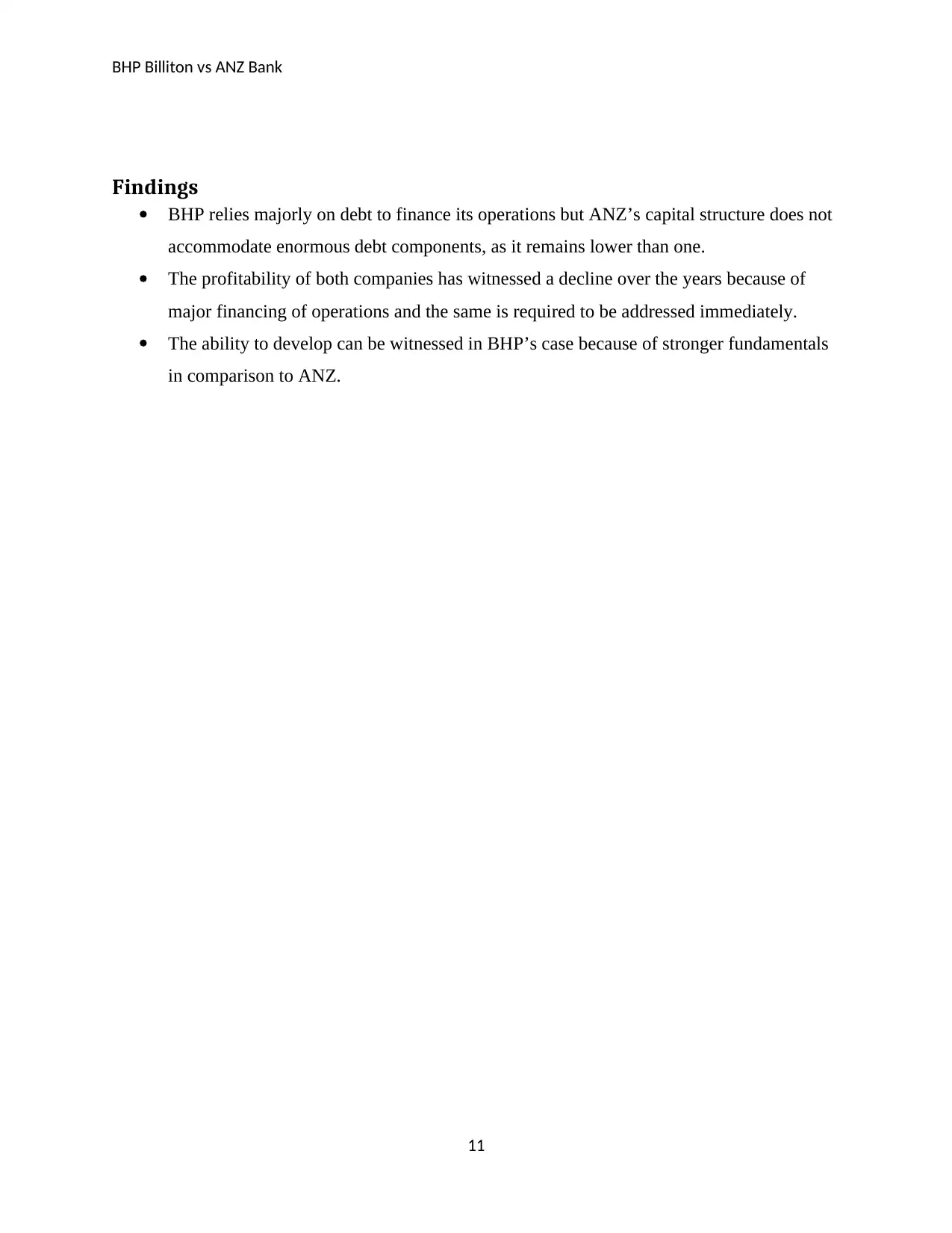
BHP Billiton vs ANZ Bank
Findings
BHP relies majorly on debt to finance its operations but ANZ’s capital structure does not
accommodate enormous debt components, as it remains lower than one.
The profitability of both companies has witnessed a decline over the years because of
major financing of operations and the same is required to be addressed immediately.
The ability to develop can be witnessed in BHP’s case because of stronger fundamentals
in comparison to ANZ.
11
Findings
BHP relies majorly on debt to finance its operations but ANZ’s capital structure does not
accommodate enormous debt components, as it remains lower than one.
The profitability of both companies has witnessed a decline over the years because of
major financing of operations and the same is required to be addressed immediately.
The ability to develop can be witnessed in BHP’s case because of stronger fundamentals
in comparison to ANZ.
11
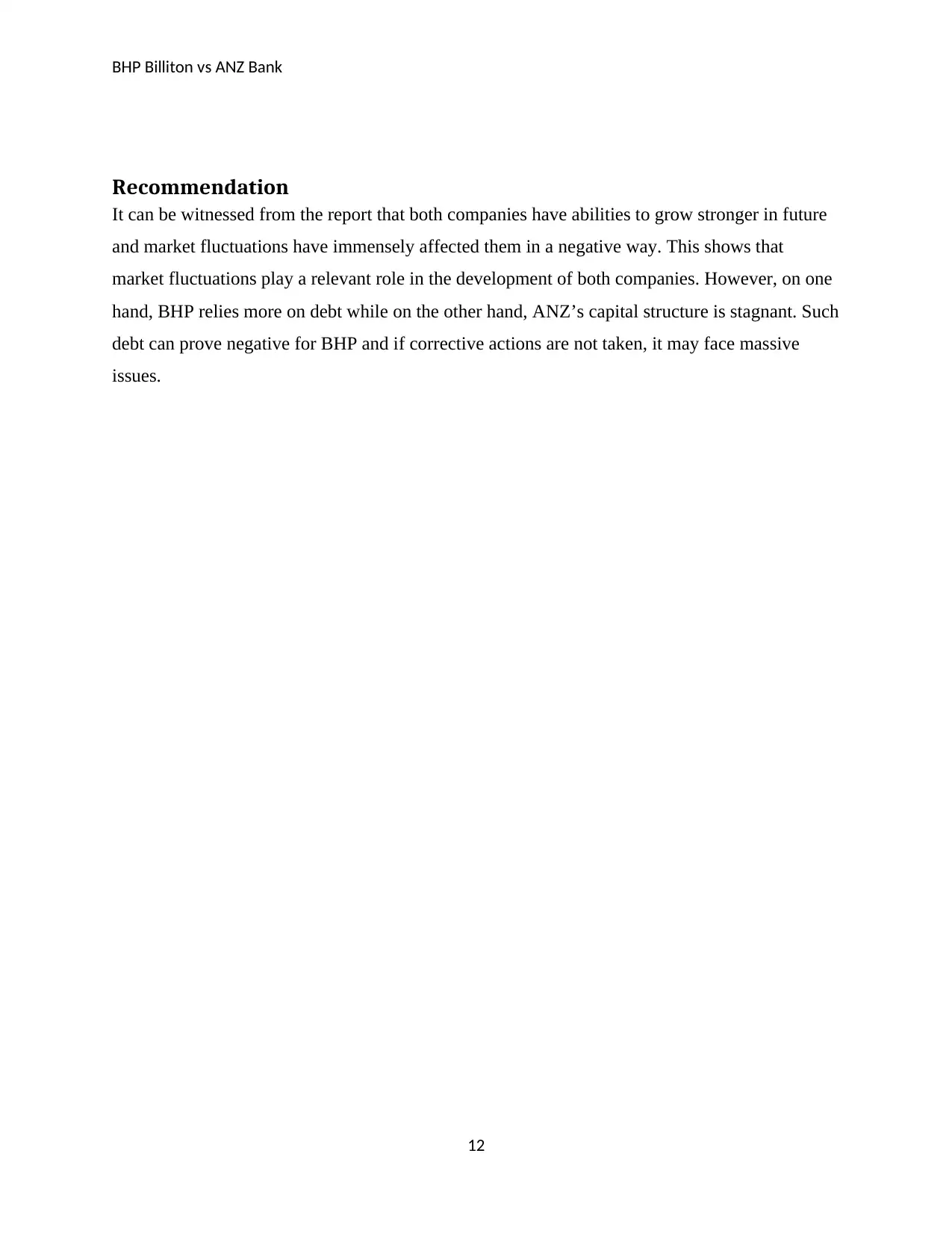
BHP Billiton vs ANZ Bank
Recommendation
It can be witnessed from the report that both companies have abilities to grow stronger in future
and market fluctuations have immensely affected them in a negative way. This shows that
market fluctuations play a relevant role in the development of both companies. However, on one
hand, BHP relies more on debt while on the other hand, ANZ’s capital structure is stagnant. Such
debt can prove negative for BHP and if corrective actions are not taken, it may face massive
issues.
12
Recommendation
It can be witnessed from the report that both companies have abilities to grow stronger in future
and market fluctuations have immensely affected them in a negative way. This shows that
market fluctuations play a relevant role in the development of both companies. However, on one
hand, BHP relies more on debt while on the other hand, ANZ’s capital structure is stagnant. Such
debt can prove negative for BHP and if corrective actions are not taken, it may face massive
issues.
12
⊘ This is a preview!⊘
Do you want full access?
Subscribe today to unlock all pages.

Trusted by 1+ million students worldwide
1 out of 15
Related Documents
Your All-in-One AI-Powered Toolkit for Academic Success.
+13062052269
info@desklib.com
Available 24*7 on WhatsApp / Email
![[object Object]](/_next/static/media/star-bottom.7253800d.svg)
Unlock your academic potential
Copyright © 2020–2025 A2Z Services. All Rights Reserved. Developed and managed by ZUCOL.





